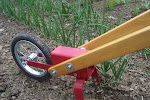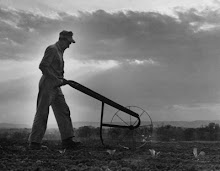.
Here is what Eliot Coleman writes about how to use a wheel hoe in his book, The New Organic Grower:
”A wheel hoe equipped with an oscillating blade makes for pleasant work. The operator walks forward at a steady pace while making smooth push-pull motions with the arms. The push-pull takes full advantage of the swinging action of the oscillating blade and keeps its cutting edges free from debris.”
That little paragraph pretty much sums it up. The necessary motion is not difficult at all. In fact, it comes naturally and you’ll develop your own hoeing style in no time. You can see a 30-second movie of the Glaser wheel hoe in use and get an idea of how the push-pull action works At This Link.
Hoeing At The Right Time
I want to make it clear that the wheel hoe with an oscillating stirrup blade is best suited for cutting small, fledgling weeds. Simply disturbing the top 1” of soil will be sufficient to kill such weeds before they get a foothold. And periodic shallow cultivation is the trick to keeping your garden free of weeds for the whole garden season (make sure to read The Secret To Easy Weed Control).
A Solution For The Footprint Problem
One drawback to the wheel hoe is that when you push it ahead of you, the stirrup blade cultivates the soil, then you walk right over the just-cultivated area. This leaves footprints. Each footprint compacts the soil, thus replanting disturbed seedlings. In other words, you defeat the purpose of cultivating—at least in the area where your feet step.
There are two hoeing techniques for eliminating the footprints....
First, with the 8” stirrup hoe, it is possible to walk just to the side of the cultivated section, and this is not difficult to do.
The other “trick” is to simply walk backwards down the row. Again, this is an easy thing to do while working the hoe in a push-pull cultivating action in front of you. Try it and you’ll see it for yourself.
My own garden, now consists of many raised beds (with no permanent curbs—just raised soil—that are 4-foot wide and 50-foot long. Adjoining beds are spaced 2-feet apart, forming a walkway. I use a Collinear Hoe to quickly and easily cultivate the beds while standing in the walkways. Then, when I’m done, I use the wheel hoe to cultivate the walkways.
I do this by making a forward pass up alongside each of the beds while walking in the middle of the walkway. This renders two outside swaths of cultivated soil with no footprints. Then I finish up by cultivating right down the center of the walkway by walking backwards. The only impression on the cultivated area is that of the hoe’s rubber wheel, which is minor.
Now, here’s the best part of this whole thing: I can cultivate that walkway in about three minutes without bending my back or breaking a sweat. Please understand that I can cultivate that amount of area so quickly because I have been cultivating it lightly and frequently since planting, and have not let the weeds get established. If I had not done this, and there were a lot of well-rooted weeds, the job of cultivating would take longer.
Wheel Hoeing & The Black Knight
The oscillating blade will easily slice through more established weeds, severing the roots from the tops. But sometimes the severed weeds will remain standing, just as though nothing happened to them.
It reminds me of that Monty Python scene where King Arthur has a sword fight with The Black Knight. Arthur cuts off one of the knight’s arms, then the other. To this, the knight responds, “It’s just a flesh wound,” and kicks the king.
But just because a hoed weed may appear unharmed, it is mortally wounded. It just doesn’t know it yet. Within a day or so, it will wilt and die. In the event that a large, root-severed weed does manage to re-root and survive against the odds, it will be weakened and you’ll get it the next time you pass by with the hoe.
skip to main |
skip to sidebar

....with an 8" Oscillating Stirrup Blade (It makes gardening a hoe lot easier!)

The Planet Whizbang Wheel Hoe...
....with an 8" Oscillating Stirrup Blade (It makes gardening a hoe lot easier!)
Feedback....
Wheel Hoe Specifications
For Garden Trellising Instruction....






